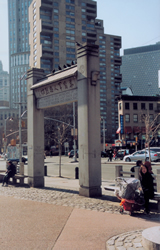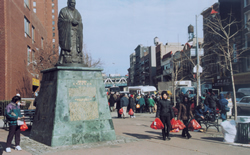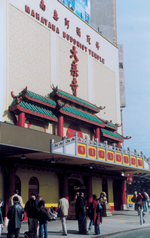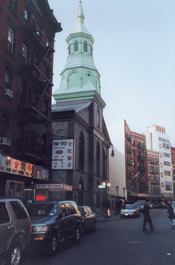 |  | While we highly recommend the guided tours listed on this site, this is the place for you do-it-yourself travelers out there who want to explore Chinatown yourself. Here you'll find themed tours, from the general to the specific, for a variety of interests, which you can take at your own pace. Just print them, along with the map-guide, and go! Check back from time to time for new tours, and send us your suggestions for attractions, restaurants or fun stops to include in future tours. And don't forget the Chinatown Info Kiosk on Canal Street at Baxter & Walker, your "home base" to ask questions or to pick up a copy of the map-guide or other materials. Enjoy New York City's Chinatown! |
|
 Start in Chatham Square. This is an ideal starting point for exploring Chinatown, because so many other streets run into it or are just steps away, including Mott, Doyers, Bowery and East Broadway. The square is named after the Earl of Chatham, William Pitt, who supported the American opposition to the Stamp Act, a tax on printed papers imposed on all American colonists by the British in 1765. Chatham Square was the entertainment center of the city in the 19th Century, the Times Square of its time. Start in Chatham Square. This is an ideal starting point for exploring Chinatown, because so many other streets run into it or are just steps away, including Mott, Doyers, Bowery and East Broadway. The square is named after the Earl of Chatham, William Pitt, who supported the American opposition to the Stamp Act, a tax on printed papers imposed on all American colonists by the British in 1765. Chatham Square was the entertainment center of the city in the 19th Century, the Times Square of its time.
Located in the middle of Chatham Square is the Kim Lau Memorial Arch, erected in 1962 and dedicated to the memory of the Chinese Americans who died in World War II. The arch is named for Lt. Benjamin Kim Lau, an aircraft commander in the Second World War.
Also in Chatham Square is a statue of Lin Ze Xu. You might call Lin Ze Xu the world's first drug czar. Appointed by the Emperor of China in 1838 and charged with eradicating opium in China, he took on the East India Company, which was selling increasing quantities of the drug in China. He quickly confiscated and destroyed some 2.6 million pounds of opium, which led to the Opium War with Britain. China lost the war but Lin Ze Xu remained a symbol of moral resistance and is considered a national hero of China. In recognition of his efforts, the United Nations declared June 26th-the anniversary of the opium destruction-as International Anti-Narcotics Day, and New York Mayor Rudolph Giuliani signed a bill adding the name "Commissioner Lin Ze Xu Square" to East Broadway between Oliver and Catherine Streets.
- Confucius Plaza. Just east of Chatham Square, on Division Street, lies Confucius Plaza, where a statue of the famous philosopher stands. A gift from the Chinese Consolidated Benevolent Association in 1976, the statue features Confucius's sayings in both Chinese and English.

The Confucius Plaza housing development was at the center of a political battle in 1974, as advocates for minorities and Asian immigrants succeeded in getting the builder to hire 27 of them for the project. Out of this struggle was born the advocacy group Asian Americans for Equality.
- Just south of Chatham Square, on St. James Place, is the First Shearith Israel Cemetery, the oldest Jewish cemetery in New York City. It was founded in 1683 by descendents of survivors of the Spanish Inquisition, who had already been expelled from Spain and Brazil. Buried here are 18 Jewish Revolutionary-War era soldiers and patriots, as well as the first American-born rabbi.
- Walk north from Chatham Square on Bowery and you will pass Doyers Street on your left. If any street could qualify as a landmark, Doyers would be it. This tiny street features a 90-degree turn; legend has it the merchants built it that way so the straight-flying ghosts couldn't move through it. You may recognize the street from films and TV programs. Today you'll find the local post office, one of Chinatown's first dim sum restaurants, teahouses and lots of barber shops.
- Continuing north on Bowery, you will pass the oldest townhouse in New York City, which was recently restored. The Edward Mooney House was built in 1785, following the Revolutionary War, by a butcher. It became a tavern in the 1820's, a store and hotel in the early 20th century, then a pool parlor, a restaurant, a Chinese club and a bank. The architecture of the front of the building reflects the late Georgian style favored by the British, while the side facing Pell Street anticipates the Federal style that would become popular in New York City.
 Walk north on Bowery to Canal Street and turn right on Canal to get to the Mahayana Buddhist Temple, which sits across from the Manhattan Bridge. The exterior of the largest Buddhist temple in Chinatown features two giant golden lions whose job is to protect the temple from evil spirits. But the most inspiring feature is inside: a 16-foot high golden Buddha, thought to be the largest statue of Buddha in the city, seated on a lotus. In the lobby are many benches for resting near paintings depicting events in the life of Buddha and altars for bodhisattvas, devotees to the path of enlightenment. Candles and strips of paper with Chinese characters hold prayers and names of deceased loved ones. Nearby is a large urn where incense is burned. Public services with bells and drums are usually conducted on the weekend. Fortunes are read daily for a contribution of one dollar. Walk north on Bowery to Canal Street and turn right on Canal to get to the Mahayana Buddhist Temple, which sits across from the Manhattan Bridge. The exterior of the largest Buddhist temple in Chinatown features two giant golden lions whose job is to protect the temple from evil spirits. But the most inspiring feature is inside: a 16-foot high golden Buddha, thought to be the largest statue of Buddha in the city, seated on a lotus. In the lobby are many benches for resting near paintings depicting events in the life of Buddha and altars for bodhisattvas, devotees to the path of enlightenment. Candles and strips of paper with Chinese characters hold prayers and names of deceased loved ones. Nearby is a large urn where incense is burned. Public services with bells and drums are usually conducted on the weekend. Fortunes are read daily for a contribution of one dollar.
- Walk west on Canal Street to Mulberry Steet (or continue one more block west to the Chinatown information kiosk to get your bearings, pick up a map-guide or other materials or ask questions) turn left and walk to Bayard Street. You'll be at the Museum of Chinese in the Americas, one of the most important national archives of Chinese history in America. The museum presents a variety of permanent exhibits as well as special shows throughout the year.
- Walk west on Bayard one block to Baxter and walk south along the side of Columbus Park. The roughly four-square block area on the west to your right is where Manhattan's largest body of water stood during the 18th Century. Collect Pond teemed with freshwater fish before it was turned into a place to "collect" waste, thus earning its nickname. In the early 19th Century, the pond was drained, with a canal built to drain the dirty water into the sea. The canal was later paved over to create Canal Street.
- At the lower end of the park, you will be standing roughly in the area of Five Points, the city's infamous original slum created when developers built ramshackle housing on the drained land at the Collect Pond site before the soil had even settled. This site accommodated the massive immigration of the Germans and Irish in the 19th century, with over 40,000 residents crammed into less than a half-square mile. Out of this environment came dangerous street gangs with names like the Plug Uglies and Dead Rabbits. The neighborhood was immortalized in Martin Scorsese's film Gangs of New York.
 On the opposite side of Columbus Park, take tiny Mosco Street to Mott Street, the oldest Chinese-inhabited street in New York and still considered the heart of Chinatown. Turn left and at the intersection of Pell Street and you'll come upon the Church of the Transfiguration on your left. Known as the church of New York City immigrants, it has served, in succession, the Irish, Italian and, currently, the Chinese communities. Father Raymond Nobiletti delivers his sermon in Cantonese as well as in English. The church was built in 1801 by the English Lutheran Church and around mid-century was sold to the Roman Catholic Church of the Transfiguration. On the opposite side of Columbus Park, take tiny Mosco Street to Mott Street, the oldest Chinese-inhabited street in New York and still considered the heart of Chinatown. Turn left and at the intersection of Pell Street and you'll come upon the Church of the Transfiguration on your left. Known as the church of New York City immigrants, it has served, in succession, the Irish, Italian and, currently, the Chinese communities. Father Raymond Nobiletti delivers his sermon in Cantonese as well as in English. The church was built in 1801 by the English Lutheran Church and around mid-century was sold to the Roman Catholic Church of the Transfiguration.
- Continue walking along Mott and you'll pass the Eastern States Buddhist Temple, at 64 Mott Street. At 62 Mott Street is the Chinese Consolidated Benevolent Association (CCBA) building. At 41 Mott Street, look up or you might miss a large white building topped with the only remaining wooden pagoda roof in Chinatown. (Wooden roofing fell out of favor due to fire-hazard concerns.) 32 Mott Street is the site of the oldest and longest-running store in New York, established in 1891 and closed just a few years ago.
Feedback? Let us know if you have any suggestions for this or other tours — just email us at info@explorechinatown
Dot com
|